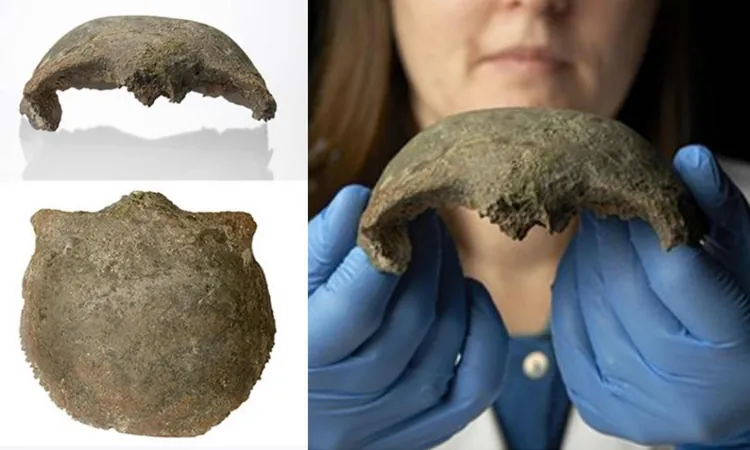
Meet Newtonsaurus: The New Triassic Titan That Time Forgot!
2025-09-15
Author: Arjun
In a remarkable twist of fate, a long-neglected fossil jawbone collected in 1899 in South Wales has finally unveiled its astonishing secret after more than a century! Lying in wait at the National Museum of Wales, this relic has now been identified as a new species of dinosaur: Newtonsaurus.
### Unveiling the Newtonsaurus Name
The fossil may lack actual bone material, consisting solely of natural molds, but that didn’t deter a team of innovative paleontologists from the University of Bristol. Thanks to cutting-edge technology, they've resurrected this ancient beast digitally. This specimen, initially known as Zanclodon cambrensis, had gone unidentified for decades.
"This specimen has been referred to many times in scientific papers but had not yet been successfully defined," noted study co-author Owain Evans. With the old name now obsolete, it was time to honor the original discoverer by naming it Newtonsaurus.
### 3D Scans Bring the Past to Life
In an impressive feat, researchers used 3D scanning to recharge this ancient find. Capturing its mold from every angle, they meticulously pieced together images to create a digital twin of the jawbone. This digital transformation revealed hidden details—every groove, ridge, and tooth serration became astonishingly clear.
Professor Michael Benton shared insights into these intricate details, stating, "The natural molds display incredible precision, uncovering features thought to be lost forever." Using photogrammetry, they created a reverse image, effectively breathing new life into the fossil.
### A Fearsome Predator of the Triassic
Once brought back to life digitally, the fossil disclosed its predatory nature. The arrangement of teeth and jaw characteristics confirmed that Newtonsaurus was a theropod—a flesh-eating dinosaur that prowled along the stunning Welsh coastline during the Triassic Period.
"This discovery establishes that large predators roamed South Wales during the late Triassic," said Evans. Newtonsaurus is a unique theropod, distinct from earlier dinosaurs, marking its place in evolutionary history.
### Size That Impresses
At an astonishing 28 centimeters (11 inches) for its jawbone, which originally extended to around 60 centimeters (24 inches), Newtonsaurus could have reached a jaw-dropping length of 5 to 7 meters (16 to 23 feet). At that time, it was an enormous predator compared to the relatively smaller theropods.
### Adding Depth to Welsh Prehistory
This incredible find is a groundbreaking addition to Wales' prehistoric record, emphasizing how even long-stored specimens can yield exciting insights. The region's Triassic beds are globally significant, and paleontologists are continuously drawn to the potential discoveries they hold.
Cindy Howells from the National Museum of Wales highlights the importance of historical specimens, stating, "These finds can contribute significantly to our understanding, even decades later. The fossil frenzy of the Victorians made the UK a hotspot for paleontology, and this is yet another chapter in that ongoing saga."
### More Dinosaurs Awaiting Discovery?
With the rarity of Triassic beds globally, Wales remains a treasure trove for future finds. Newtonsaurus proves that ancient fossils still have surprises in store, and modern technology breathes life into questions that span generations.
The cliffs and quarries of Wales may still conceal more prehistoric giants waiting to be unearthed. Keep your eyes peeled as the study of Newtonsaurus unfolds in the journal *Proceedings of the Geologists Association*, reminding us of the endless possibilities hidden in our planet's ancient past.



 Brasil (PT)
Brasil (PT)
 Canada (EN)
Canada (EN)
 Chile (ES)
Chile (ES)
 Česko (CS)
Česko (CS)
 대한민국 (KO)
대한민국 (KO)
 España (ES)
España (ES)
 France (FR)
France (FR)
 Hong Kong (EN)
Hong Kong (EN)
 Italia (IT)
Italia (IT)
 日本 (JA)
日本 (JA)
 Magyarország (HU)
Magyarország (HU)
 Norge (NO)
Norge (NO)
 Polska (PL)
Polska (PL)
 Schweiz (DE)
Schweiz (DE)
 Singapore (EN)
Singapore (EN)
 Sverige (SV)
Sverige (SV)
 Suomi (FI)
Suomi (FI)
 Türkiye (TR)
Türkiye (TR)
 الإمارات العربية المتحدة (AR)
الإمارات العربية المتحدة (AR)